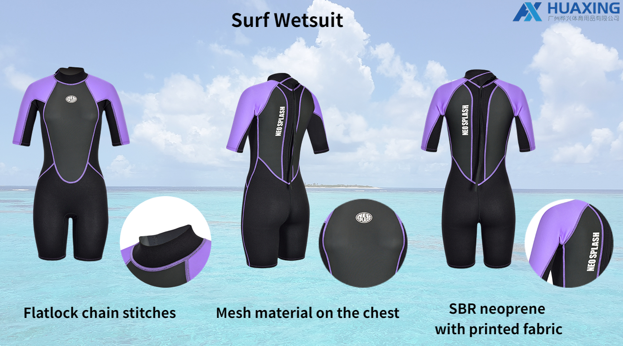What's so good about neoprene?
Put on a wetsuit and everything changes. A wetsuit is made from multiple layers and, most importantly, a thick layer of synthetic rubber called neoprene. If you're interested in chemistry, neoprene is the popular name for an organic (carbon-based) chemical called polychloroprene, which is a polymer (a very large molecule made from endlessly repeating building blocks called monomers) built from the monomer chloroprene (2-chloro-1,3-butadiene). Unless you're a chemist, that will mean nothing and you won't care! The really important thing about neoprene is that it's a kind of foam rubber with a cellular structure that has nitrogen gas bubbles trapped inside it, which make it a particularly good heat insulator.
Neoprene (polychloroprene) is a polymer built from many identical, repeating units (monomers) of chloroprene (sometimes called 2-chloro-1,3-butadiene, chlorobutadiene, and various other things). You can see the chloroprene monomer at the top and three repeated units of it in the polymer at the bottom.
Layers, layers, layers!
Most wetsuits are made from multiple layers—and these help to trap and reflect heat much like any other insulating clothes. Some are lined with a thin layer of metal such as titanium or copper to reflect your body heat back inside. That helps to keep you even warmer than a normal wetsuit. Also, as you step into the ocean, a small amount of water seeps in between the neoprene costume and your skin—and stays there. Your body quickly warms this water up to something approaching normal body temperature. So now, between you and the sea, there's an insulating layer of rubbery material, some warm water, and multiple layers of insulation—all working together like a kind of personal, all-over body radiator! Not all wetsuits are the same, but these layers are typical of what you might find between your warm body and the cold sea
Your own skin
A thin layer of trapped water warmed by your body.
A layer of nylon or some other comfortable fabric to stop the neoprene rubbing and chafing your body. (Most surfers also wear a separate rash vest between their body and their suit for the same reason—and to give an extra little bit of insulation.)
A thin layer of heat-reflecting material based on a metal oxide of titanium, copper, silver, magnesium or aluminum.
A thick layer of neoprene containing trapped bubbles of nitrogen. This is the most important part for keeping you warm.
A durable outer layer made from some water- and abrasion-resistant material.
Keep that water out!
For a wetsuit to work properly, any water that seeps in has to stay inside and stay warm. If a wetsuit fits badly, or isn't well sealed, the warm water layer will constantly "flush" in and out and be replaced by cold water from the sea—which, if you think about it, would be almost the same as wearing no wetsuit at all. As wetsuit inventor Hugh Bradner (see below) first realized, a neoprene wetsuit keeps you warm in spite of the fact that it makes you wet, not because of it. Even so, stopping cold water from flushing in and out is vital. That's why the seams of a wetsuit (where the separate panels of neoprene are joined together) are held together with special waterproof tape. They are also "blind-stitched": instead of the stitch holes going all the way through, they go only part of the way through the neoprene from the inside. That means there are no stitch holes in the outside of the neoprene to let in cold water. For the same reason, wetsuits have tight-fitting cuffs and legs.
